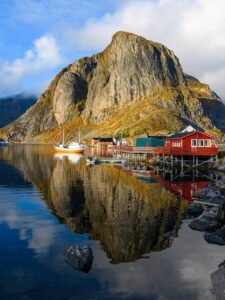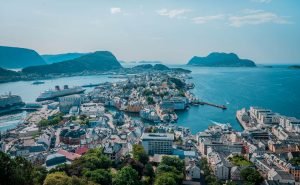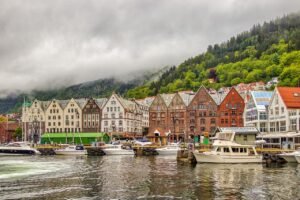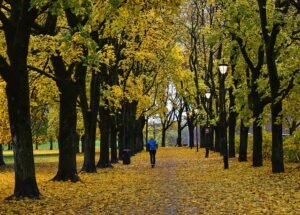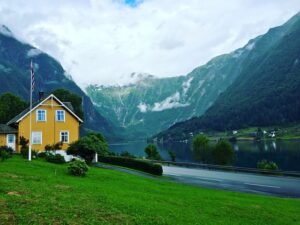

Exploring the Norwegian Countryside: Norwegian Vocabulary for Rural Adventures
Norway is known for its stunning natural beauty, and its countryside is no exception. With vast forests, towering mountains, and crystal-clear lakes, exploring the Norwegian countryside is a must-do activity for nature lovers and adventure seekers. Whether you’re interested in hiking, fishing, camping, or simply immersing yourself in the tranquility of nature, Norway’s rural areas offer endless opportunities for outdoor exploration.
Table of Contents
ToggleKey Takeaways
- Exploring the Norwegian countryside offers a unique and unforgettable experience.
- Learning essential Norwegian vocabulary can enhance your rural adventures.
- Proper planning is crucial for a successful countryside adventure in Norway.
- Hiking and trekking in the Norwegian wilderness is a must-do activity.
- Fishing and hunting in the Norwegian countryside can provide a thrilling experience.
Essential Norwegian Vocabulary for Rural Adventures
Before embarking on your countryside adventure in Norway, it’s helpful to familiarize yourself with some essential Norwegian vocabulary. Knowing a few common words and phrases can go a long way in enhancing your experience and connecting with the locals. Here are a few words and phrases to get you started:
– Takk (thank you)
– Hei (hello)
– Ja (yes)
– Nei (no)
– Vær så snill (please)
– Hvor er…? (Where is…?)
– En kopp kaffe, takk (One cup of coffee, please)
– Kan du hjelpe meg? (Can you help me?)
– God morgen (good morning)
– Ha det bra (goodbye)
Pronouncing Norwegian words correctly can be a bit challenging for non-native speakers. However, with a little practice, you’ll be able to communicate effectively. One important thing to note is that Norwegian has several dialects, so pronunciation may vary depending on the region you’re in. It’s always a good idea to listen carefully to locals and try to mimic their pronunciation.
Planning Your Norwegian Countryside Adventure
When planning your trip to explore the Norwegian countryside, there are a few factors to consider. Firstly, the best time to visit Norway’s rural areas is during the summer months of June to August when the weather is mild and the days are long. This is also the peak tourist season, so be prepared for larger crowds and higher prices.
Getting around in the countryside can be a bit challenging, especially if you’re relying on public transportation. While Norway has an extensive network of buses and trains, they may not reach all remote areas. Renting a car is often the best option for exploring the countryside at your own pace. Alternatively, you can join guided tours or hire a local guide who can take you to the hidden gems of Norway’s rural areas.
When it comes to gear and equipment, it’s important to be prepared for the unpredictable weather conditions in Norway. Layered clothing, waterproof jackets, sturdy hiking boots, and a good backpack are essential items to pack. Additionally, don’t forget to bring a map, compass, and a first aid kit for emergencies.
Hiking and Trekking in the Norwegian Wilderness
Norway is a hiker’s paradise, with countless trails that wind through its breathtaking landscapes. From gentle walks to challenging multi-day treks, there’s something for every level of hiker. Some of the most popular hiking trails in Norway include the Trolltunga, Preikestolen (Pulpit Rock), and the Besseggen Ridge.
Safety is paramount when hiking in the Norwegian wilderness. It’s important to be well-prepared and informed about the trail conditions before setting off. Check the weather forecast, bring enough food and water, and let someone know about your hiking plans. It’s also advisable to hike with a buddy or join a guided tour for added safety.
During your hiking trip in Norway, you can expect stunning views of fjords, waterfalls, and snow-capped mountains. You may also encounter wildlife such as reindeer, moose, and eagles along the way. Remember to respect nature by staying on marked trails, leaving no trace behind, and following any regulations or guidelines set by local authorities.
Fishing and Hunting in the Norwegian Countryside
Norway is renowned for its abundant fish and game, making it a paradise for fishing and hunting enthusiasts. The country offers a wide variety of fish species, including salmon, trout, cod, and Arctic char. In terms of hunting, popular game species in Norway include moose, reindeer, grouse, and hare.
Before embarking on a fishing or hunting trip in Norway, it’s important to familiarize yourself with the regulations and obtain the necessary permits. Fishing licenses can be purchased online or from local tourist offices, while hunting permits are typically issued by local authorities.
Some of the best places to fish in Norway include the rivers and lakes in the Telemark region, the Lofoten Islands, and the Hardangerfjord. For hunting, the vast forests of Hedmark and Oppland are popular destinations. It’s always a good idea to hire a local guide who can provide valuable insights and ensure you have a successful and ethical experience.
Camping and Outdoor Living in Norway
Camping is a popular activity in Norway, and there are plenty of options for outdoor enthusiasts. From traditional tent camping to RV camping and glamping, there’s something for every type of camper. Norway has a unique “right to roam” law called allemannsretten, which allows everyone to camp on uncultivated land for up to two nights without permission from the landowner.
When setting up camp in the Norwegian wilderness, it’s important to choose a suitable location that is at least 150 meters away from residential buildings or cultivated land. Leave no trace behind by properly disposing of waste and respecting nature. It’s also advisable to bring a portable stove for cooking instead of making open fires.
Safety is paramount when camping in Norway. Be prepared for changing weather conditions by bringing appropriate clothing and gear. It’s also important to be aware of potential hazards such as avalanches, falling rocks, and wildlife encounters. Familiarize yourself with the emergency procedures and contact information for local authorities before setting off on your camping adventure.
Wildlife and Nature in the Norwegian Countryside
Norway is home to a diverse range of flora and fauna, making it a haven for nature lovers. The country’s unique ecosystems support a variety of wildlife, including reindeer, lynx, wolves, and polar bears. Norway is also known for its rich birdlife, with over 400 species recorded.
To spot wildlife in Norway, it’s best to visit national parks and nature reserves such as Dovrefjell-Sunndalsfjella National Park and Hardangervidda National Park. These protected areas offer opportunities to see rare species in their natural habitats. Remember to keep a safe distance from wildlife and never feed or disturb them.
Respecting and protecting Norway’s natural environment is crucial for its preservation. Follow the principles of Leave No Trace by minimizing your impact on the environment. Avoid picking flowers or disturbing vegetation, and dispose of waste properly. It’s also important to stay on marked trails to avoid damaging fragile ecosystems.
Traditional Norwegian Food and Drink in Rural Areas
Exploring the Norwegian countryside wouldn’t be complete without indulging in traditional Norwegian food and drink. Norway is known for its seafood, particularly salmon and cod. Other popular dishes include rakfisk (fermented fish), lutefisk (dried fish), and fårikål (mutton stew). For a sweet treat, try traditional Norwegian pastries such as krumkake and lefse.
To experience authentic Norwegian cuisine, head to local restaurants, farm-to-table establishments, or traditional food markets. These places offer a taste of regional specialties made with locally sourced ingredients. Don’t forget to pair your meal with aquavit, a traditional Norwegian spirit flavored with herbs and spices.
If you’re feeling adventurous, you can even try your hand at preparing and cooking Norwegian food yourself. Many local tourist offices offer cooking classes where you can learn traditional recipes and techniques. Alternatively, you can visit local farms and participate in food workshops to gain a deeper understanding of Norwegian culinary traditions.
Cultural and Historical Sites in the Norwegian Countryside
Norway’s countryside is not only rich in natural beauty but also steeped in cultural and historical heritage. From ancient Viking sites to traditional stave churches, there are plenty of cultural and historical landmarks to explore. Some notable sites include the Bryggen Wharf in Bergen, the Nidaros Cathedral in Trondheim, and the Viking Ship Museum in Oslo.
In addition to historical landmarks, Norway’s rural areas are known for their traditional architecture and design. The iconic red wooden houses, known as “stabbur,” can be found throughout the countryside. These charming buildings often feature intricate carvings and are a testament to Norway’s architectural heritage.
To learn more about Norway’s cultural heritage, visit local museums and cultural centers. These institutions offer exhibitions and interactive displays that provide insights into the country’s history, traditions, and way of life. You can also participate in cultural events such as folk festivals and traditional music concerts to immerse yourself in Norwegian culture.
Tips for Sustainable and Responsible Travel in Norway’s Rural Areas
As you explore Norway’s countryside, it’s important to practice sustainable and responsible travel to minimize your impact on the environment and support local communities. Here are a few tips to keep in mind:
1. Respect nature: Follow the principles of Leave No Trace by leaving nature as you found it. Avoid picking flowers or disturbing vegetation, and dispose of waste properly.
2. Support local businesses: Choose locally owned accommodations, restaurants, and shops to support the local economy. This helps preserve the unique character of rural areas and ensures that tourism benefits the community.
3. Learn about local customs and traditions: Take the time to learn about the local customs and traditions of the areas you visit. Respect cultural practices and be mindful of local sensitivities.
4. Use sustainable transportation: Opt for public transportation or eco-friendly modes of transportation whenever possible. Consider renting a bike or walking to explore the countryside.
5. Conserve resources: Be mindful of your water and energy consumption. Take short showers, turn off lights when not in use, and conserve water when camping.
By following these tips, you can enjoy your Norwegian countryside adventure while minimizing your impact on the environment and supporting local communities.
Exploring the Norwegian countryside offers a unique opportunity to immerse yourself in nature, experience traditional Norwegian culture, and create lasting memories. From hiking and fishing to camping and wildlife spotting, there’s something for everyone in Norway’s rural areas. By planning your trip carefully, respecting nature and local communities, and practicing sustainable travel, you can make the most of your countryside adventure while preserving Norway’s natural and cultural heritage for future generations to enjoy. So pack your bags, put on your hiking boots, and get ready to embark on an unforgettable journey through the stunning landscapes of Norway’s countryside.
If you want to learn Norwegian, you can register for classes here. We look forward to hearing from you and helping you become fluent in Norwegian.

